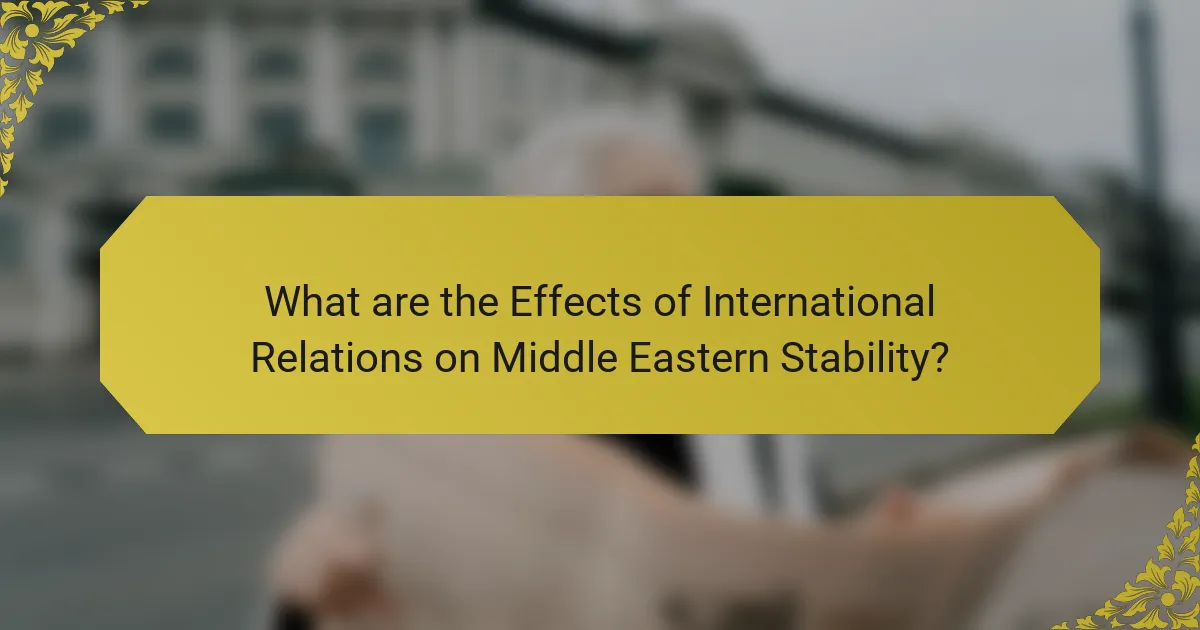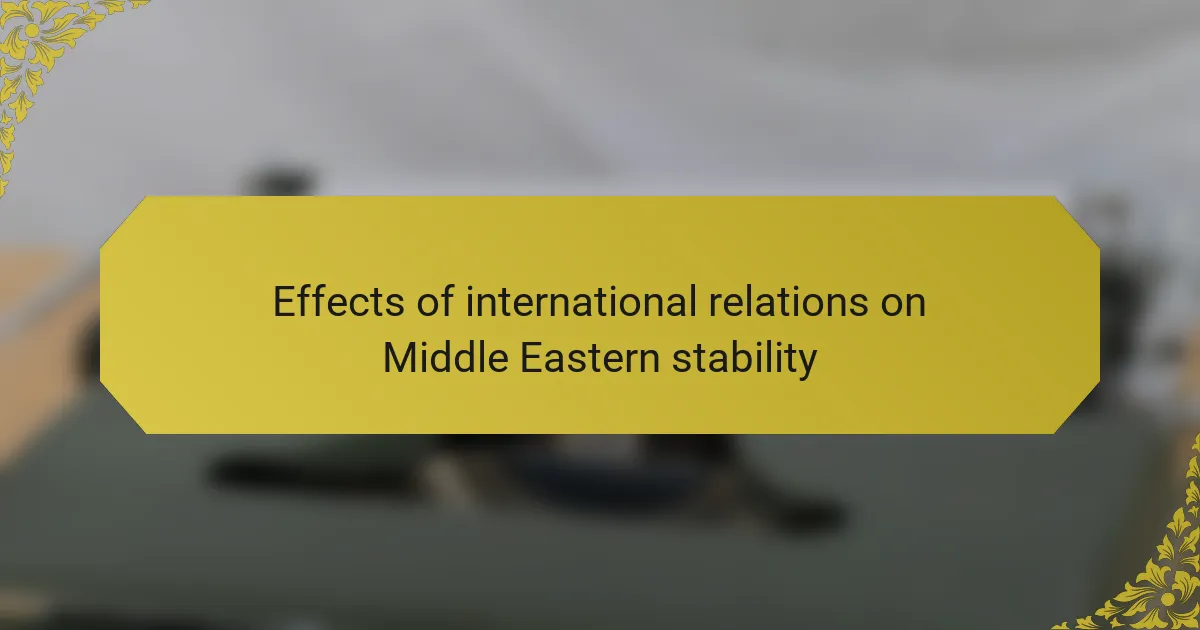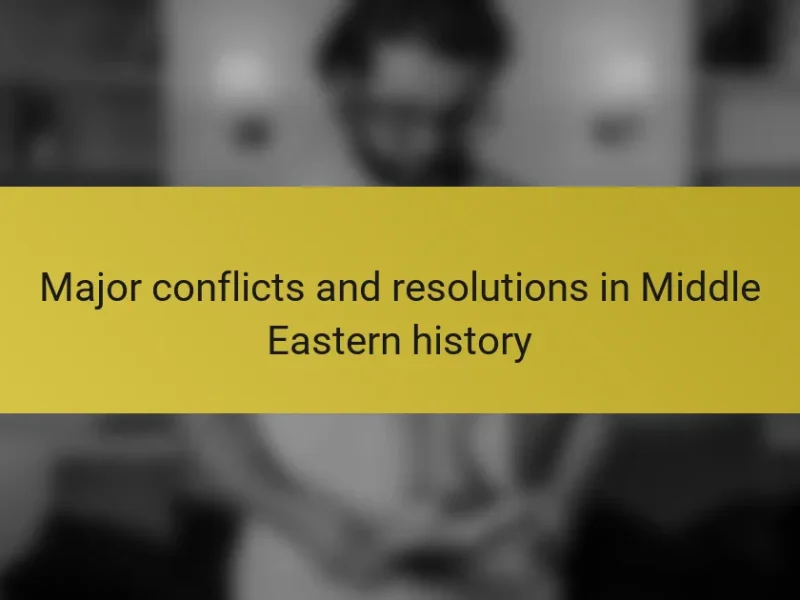
What are the Effects of International Relations on Middle Eastern Stability?
International relations significantly impact Middle Eastern stability. Diplomatic ties influence regional security dynamics. For instance, alliances can deter aggression among neighboring states. Conversely, tensions between major powers can exacerbate conflicts. The Arab Spring highlighted how international support or lack thereof affects internal stability. Economic sanctions imposed by foreign nations can destabilize economies, leading to unrest. Additionally, foreign military interventions have altered power balances in countries like Iraq and Libya. Therefore, international relations play a crucial role in shaping the political landscape and stability of the Middle East.
How do international relations influence political stability in the Middle East?
International relations significantly influence political stability in the Middle East. Diplomatic ties between countries can either foster peace or escalate tensions. For example, alliances with Western nations often provide military and economic support. Conversely, rivalries, such as those between Iran and Saudi Arabia, can lead to proxy conflicts. Trade agreements may enhance economic interdependence, reducing the likelihood of conflict. Additionally, international organizations play a role in mediating disputes. The presence of foreign military forces can stabilize or destabilize regions, depending on their actions. Historical events, like the Arab Spring, illustrate how international dynamics can trigger political upheaval. Overall, the interplay of international relations is crucial in shaping the political landscape of the Middle East.
What role do diplomatic relations play in regional stability?
Diplomatic relations are crucial for regional stability. They facilitate dialogue and negotiation, reducing the likelihood of conflict. Effective diplomacy helps manage disputes and fosters cooperation among states. For example, peace treaties often result from diplomatic efforts, which stabilize regions. Historical instances, such as the Camp David Accords, demonstrate how diplomacy can lead to lasting peace. Additionally, diplomatic relations can enhance economic ties, promoting interdependence. This interdependence can deter aggression, as countries are less likely to engage in conflict with key trading partners. Overall, strong diplomatic relations contribute significantly to maintaining stability in regions like the Middle East.
How do international conflicts affect domestic politics in Middle Eastern countries?
International conflicts significantly influence domestic politics in Middle Eastern countries. They can lead to increased nationalism and political polarization. Governments often exploit foreign conflicts to rally public support. This can justify authoritarian measures or suppress dissent. For example, during the Syrian civil war, the Assad regime framed opposition as a threat to national security. Additionally, international alliances shape internal power dynamics. Countries may align with external powers, affecting local governance and policy decisions. Economic impacts from conflicts, such as sanctions, can also lead to public unrest. The Arab Spring illustrates how international factors can trigger domestic upheaval. Thus, international conflicts are a key driver of political changes in the region.
What economic impacts do international relations have on Middle Eastern stability?
International relations significantly influence Middle Eastern stability through economic channels. Trade agreements can enhance economic cooperation among nations, fostering stability. For example, the Abraham Accords led to increased trade between Israel and several Arab nations, boosting economic interdependence. Economic sanctions, on the other hand, can destabilize nations, leading to unrest. The sanctions imposed on Iran have contributed to economic hardship and social discontent. Foreign investments can also play a critical role. Increased foreign direct investment (FDI) in the region can lead to job creation and infrastructure development. This, in turn, helps stabilize economies and reduce tensions. Conversely, political conflicts can deter investment, exacerbating economic challenges. The ongoing Syrian conflict has led to a significant decline in foreign investment in that country, worsening its economic situation. Thus, the interplay between international relations and economic factors is crucial for understanding Middle Eastern stability.
How do trade agreements influence economic stability in the region?
Trade agreements significantly influence economic stability in the region by promoting trade and investment. They reduce tariffs and barriers, facilitating easier access to markets. This increased trade can lead to higher economic growth rates. For example, the North American Free Trade Agreement (NAFTA) boosted trade among the U.S., Canada, and Mexico, leading to job creation and economic expansion. Additionally, trade agreements can attract foreign direct investment, further enhancing economic stability. In the Middle East, agreements like the Gulf Cooperation Council (GCC) Free Trade Agreement aim to strengthen economic ties between member states. Research shows that regions with robust trade agreements often experience lower volatility in economic performance. Thus, trade agreements are crucial in fostering a stable economic environment.
What is the effect of foreign aid on Middle Eastern countries’ stability?
Foreign aid can have both stabilizing and destabilizing effects on Middle Eastern countries. In some cases, it provides essential resources for development and humanitarian needs. For instance, aid can improve infrastructure, healthcare, and education, contributing to social stability. However, foreign aid can also lead to dependency, reducing local governance effectiveness. This dependency may result in weaker state institutions and increased corruption. Research from the World Bank indicates that countries receiving high levels of aid often struggle with governance issues. Additionally, aid can exacerbate tensions if perceived as favoring certain groups or regimes. The complex dynamics of foreign aid in the region highlight its dual potential to either support or undermine stability.
What social consequences arise from international relations in the Middle East?
International relations in the Middle East lead to significant social consequences. These consequences include heightened sectarian tensions among various religious and ethnic groups. For example, the Syrian civil war has exacerbated Sunni-Shia divisions. This division often results in violence and social fragmentation within communities. Additionally, foreign interventions can disrupt local governance structures, leading to instability. The influx of refugees from conflict zones creates strain on host countries, impacting social services and community cohesion. Furthermore, international sanctions can lead to economic hardships, which exacerbate social unrest. Overall, these factors contribute to a complex social landscape influenced by international relations in the region.
How do international alliances shape societal perceptions and conflicts?
International alliances significantly influence societal perceptions and conflicts. These alliances can create a sense of solidarity among member nations. They often shift public opinion in favor of collective interests. For instance, NATO’s formation in 1949 fostered a shared identity among Western nations against the Soviet threat. This unity can minimize internal conflicts within member states. Conversely, alliances can exacerbate tensions with non-member countries. The U.S.-Saudi alliance, for example, has led to increased anti-American sentiment in parts of the Middle East. Such sentiments can fuel conflicts, as seen in the regional repercussions of the Gulf War. Ultimately, the nature of international alliances shapes both societal views and the landscape of conflicts.
What is the impact of cultural exchanges on regional stability?
Cultural exchanges positively impact regional stability by fostering mutual understanding and reducing tensions. These exchanges promote dialogue among diverse groups. They can lead to increased cooperation in trade, education, and cultural initiatives. For instance, programs like student exchanges and joint cultural festivals enhance interpersonal relationships. Historical evidence shows that nations engaging in cultural diplomacy often experience lower conflict rates. The U.S. State Department’s Bureau of Educational and Cultural Affairs reported that cultural programs improve international relations. In the Middle East, successful cultural exchanges have contributed to peace initiatives, supporting stability in conflict-prone areas.
How can shifts in international policy affect Middle Eastern stability?
Shifts in international policy can significantly affect Middle Eastern stability. Changes in foreign aid can alter power dynamics within the region. For instance, a reduction in U.S. military support to allies can embolden adversaries. This was evident during the Arab Spring when U.S. policy shifts led to instability in countries like Egypt and Libya. Additionally, international sanctions can weaken economies, causing social unrest. The 2015 Iran nuclear deal showcased how diplomatic engagement can lead to reduced tensions. Conversely, the U.S. withdrawal from the deal in 2018 escalated hostilities. Overall, international policy directly influences security, governance, and economic conditions in the Middle East.
What are the historical precedents for international relations and stability in the region?
Historical precedents for international relations and stability in the Middle East include the Sykes-Picot Agreement of 1916. This agreement divided Ottoman territories between Britain and France, laying the groundwork for modern state boundaries. The establishment of Israel in 1948 led to ongoing conflicts with neighboring Arab states. The Camp David Accords in 1978 marked the first peace agreement between Israel and an Arab country, Egypt. The Gulf War in 1990-1991 demonstrated the impact of international coalitions on regional stability. The U.S.-led invasion of Iraq in 2003 destabilized the region further, leading to the rise of extremist groups. These events illustrate the complex interplay of international relations and stability in the Middle East.
What strategies can be employed to enhance stability through international relations?
Diplomatic engagement is a key strategy to enhance stability through international relations. It involves fostering dialogue between nations to resolve conflicts peacefully. Historical examples include the Camp David Accords, which helped stabilize relations between Egypt and Israel. Economic cooperation is another strategy. Trade agreements can create interdependence, reducing the likelihood of conflict. The European Union exemplifies this by promoting economic ties to ensure peace among member states. Multilateral organizations, such as the United Nations, play a vital role in facilitating cooperation. They provide platforms for negotiation and conflict resolution. Peacekeeping missions also contribute to stability by maintaining order in conflict zones. These strategies collectively promote a stable international environment, particularly in regions like the Middle East.
How can conflict resolution mechanisms improve regional stability?
Conflict resolution mechanisms can significantly improve regional stability by addressing underlying tensions and fostering dialogue. These mechanisms facilitate communication between conflicting parties. They help to identify mutual interests and common goals. By promoting negotiation, they reduce the likelihood of violence. Historical examples show that successful mediation can lead to lasting peace agreements. For instance, the Camp David Accords in 1978 stabilized relations between Egypt and Israel. This led to decades of reduced conflict in the region. Additionally, conflict resolution encourages cooperative frameworks for economic and social development. Such frameworks can enhance trust and collaboration among nations. Overall, effective conflict resolution mechanisms create an environment conducive to peace and stability.
What role do international organizations play in fostering stability?
International organizations play a crucial role in fostering stability by promoting cooperation among nations. They facilitate dialogue and negotiation, which helps to prevent conflicts. Organizations like the United Nations provide a platform for addressing global issues. They also offer peacekeeping missions to maintain order in conflict zones. Additionally, international organizations provide humanitarian aid during crises. This support helps to stabilize regions by addressing immediate needs. Their involvement often leads to long-term development strategies. For instance, the World Bank invests in infrastructure projects that promote economic stability. Overall, their efforts contribute significantly to peace and security in the Middle East.
What are the key takeaways for understanding international relations and Middle Eastern stability?
International relations significantly influence Middle Eastern stability. Key takeaways include the role of external powers in regional conflicts. For instance, the United States and Russia have vested interests in the area. Their involvement often escalates tensions rather than alleviating them. Additionally, regional alliances, such as those among Gulf states, impact stability dynamics. Historical grievances and territorial disputes also play critical roles. The Arab-Israeli conflict remains a central issue affecting relations. Economic factors, including oil dependency, further complicate stability. Understanding these elements helps clarify the intricate web of influences on Middle Eastern stability.
The primary entity of this article is the effects of international relations on Middle Eastern stability. The article examines how diplomatic ties, economic sanctions, and foreign military interventions shape the political landscape and stability in the region. Key topics include the influence of international conflicts on domestic politics, the role of trade agreements and foreign aid in economic stability, and the impact of cultural exchanges and conflict resolution mechanisms on social dynamics. Historical precedents and strategies for enhancing stability through international relations are also discussed, highlighting the complex interplay of various factors affecting the region’s stability.


